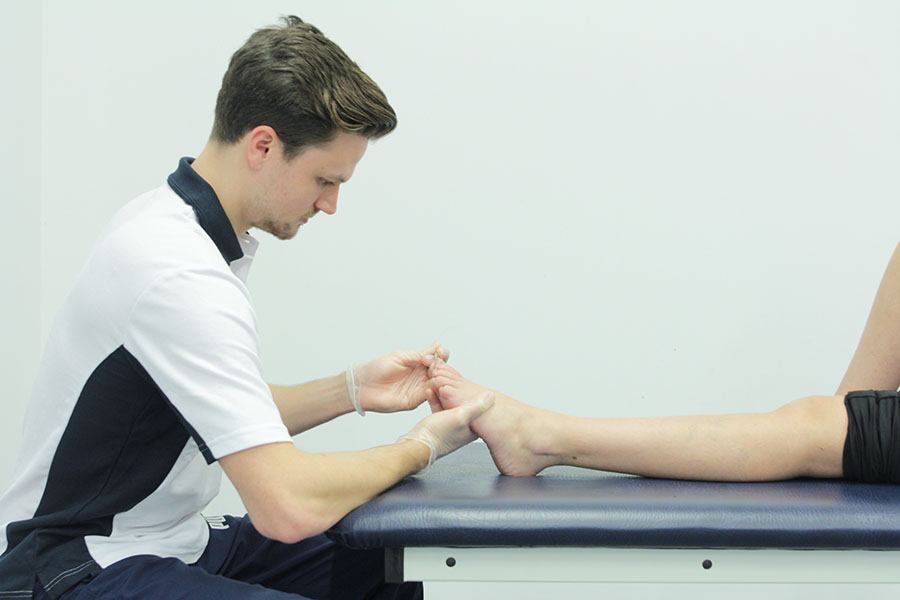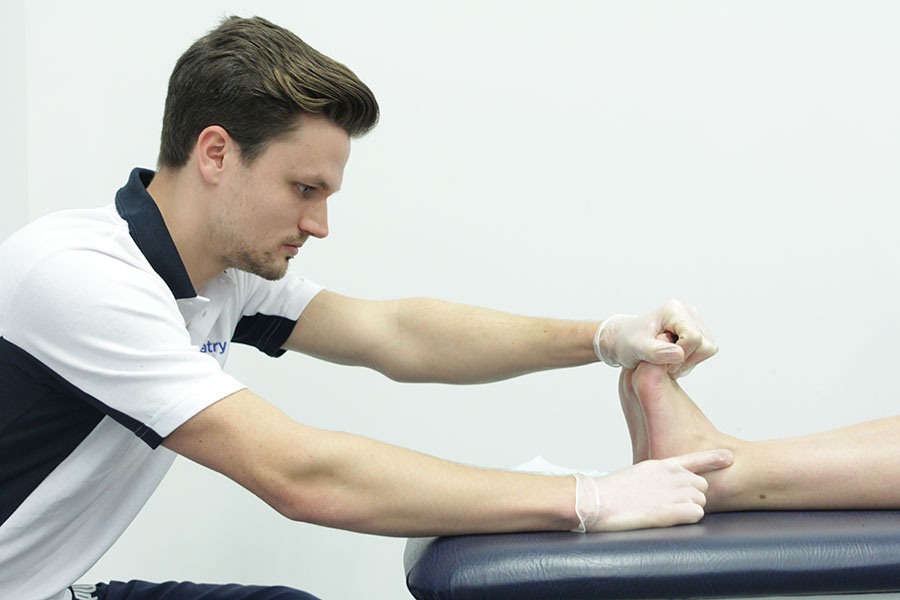Medial plantar neuropraxia
Medial plantar neuropraxia is a painful condition of the foot that results in burning heel pain. It is a rare condition, typically observed in long distance runners.
Medial plantar neuropraxia (also referred to as jogger's foot) is an uncommon cause of heel pain that is typically observed in long distance runners. Medial plantar neuropraxia involves the medial plantar nerve, which is a nerve that supplies some of the sole of the foot and some of the toes.
Medial plantar neuropraxia is a chronic entrapment syndrome, this means that the pain experienced is on-going and is caused by nerve compression. Chronic entrapment syndromes are often seen in nerves that occur in small tunnels, the medial planter nerve runs through a narrow tunnel behind a bone in the foot called the navicular.
Medial plantar neuropraxia will typically appear secondary to repetitive trauma as a result of, for example:

Medial plantar neuropraxia is quite rare, therefore it is often misdiagnosed. The following symptoms however are associated with medial plantar neuropraxia:
The diagnosis of plantar neuropraxia is made based on the signs and symptoms and a thorough history of the problem. A neurological assessment will be carried out, which tests the sensation in the feet.
If you have medial plantar neuropraxi a podiatry will benefit you. The aim of treatment for plantar neuropraxia is to:
If your symptoms are due to, for example, a cyst pressing on the nerve then surgery may be required. If surgery is needed an appropriate referral for this will be made.
Podiatry for plantar neuropraxia would involve a thorough history, which along with the physical signs and symptoms, and an examination of the area, will lead the podiatrist to a diagnosis. Once a diagnosis of plantar neuropraxia has been reached a podiatrist at Chiropody.co.uk will then discuss the treatment options available to you.
The treatment for plantar neuropraxia may consist of:

Plantar neuropraxia affects the foot and can result in burning heel pain, an aching arch, and a loss of feeling on the bottom of the foot just behind the big toe. Plantar neuropraxia is also known as jogger's foot, this is because it is a typically seen in long distance runners, caused by repetitive trauma.
Medial plantar neuropraxia is classified as a chronic entrapment syndrome. This means it is a condition that results in pain due to nerve compression. In medial plantar neuropraxia it is the media plantar nerve that is compressed, this nerve supplies feeling to part of the bottom of the foot.
If you think you have medial plantar neuropraxia visit one of our podiatrists who will be able to help. They will provide you with advice and will come up with a treatment plan specific to you.
To arrange an assessment with one our podiatrists please email office@chiropody.co.uk or call 0330 088 4222.
What is medial plantar neuropraxia?
Medial plantar neuropraxia (also referred to as jogger's foot) is an uncommon cause of heel pain that is typically observed in long distance runners. Medial plantar neuropraxia involves the medial plantar nerve, which is a nerve that supplies some of the sole of the foot and some of the toes.
Medial plantar neuropraxia is a chronic entrapment syndrome, this means that the pain experienced is on-going and is caused by nerve compression. Chronic entrapment syndromes are often seen in nerves that occur in small tunnels, the medial planter nerve runs through a narrow tunnel behind a bone in the foot called the navicular.
What causes medial plantar neuropraxia?
Medial plantar neuropraxia will typically appear secondary to repetitive trauma as a result of, for example:
- Long distance running and other demanding foot related sports
- Poor biomechanics
- Unsuitable footwear
- Acute trauma
- Compression caused by an abnormal growth, examples include:
- Cysts
- Ganglions
- Bony spurs
- Tumour
- Hypertrophic muscles

What are the signs and symptoms of medial plantar neuropraxia?
Medial plantar neuropraxia is quite rare, therefore it is often misdiagnosed. The following symptoms however are associated with medial plantar neuropraxia:
- Burning sensation at the heel
- Aching arch
- Loss of feeling on the bottom of the foot just behind the big toe
How is medial plantar neuropraxia diagnosed?
The diagnosis of plantar neuropraxia is made based on the signs and symptoms and a thorough history of the problem. A neurological assessment will be carried out, which tests the sensation in the feet.
Benefits of podiatry for medial plantar neuropraxia
If you have medial plantar neuropraxi a podiatry will benefit you. The aim of treatment for plantar neuropraxia is to:
- Reduce and redistribute pressure
- Reduce inflammation of the nerve
- Relieve pain
- Improve foot function
If your symptoms are due to, for example, a cyst pressing on the nerve then surgery may be required. If surgery is needed an appropriate referral for this will be made.
What would podiatry for medial plantar neuropraxia involve?
Podiatry for plantar neuropraxia would involve a thorough history, which along with the physical signs and symptoms, and an examination of the area, will lead the podiatrist to a diagnosis. Once a diagnosis of plantar neuropraxia has been reached a podiatrist at Chiropody.co.uk will then discuss the treatment options available to you.
The treatment for plantar neuropraxia may consist of:
- Rest or participation in low impact activity
- Orthoses
- Advice and education
- Anti-inflammatory advice
- Medication specifically for nerve pain
- Footwear modification

Summary
Plantar neuropraxia affects the foot and can result in burning heel pain, an aching arch, and a loss of feeling on the bottom of the foot just behind the big toe. Plantar neuropraxia is also known as jogger's foot, this is because it is a typically seen in long distance runners, caused by repetitive trauma.
Medial plantar neuropraxia is classified as a chronic entrapment syndrome. This means it is a condition that results in pain due to nerve compression. In medial plantar neuropraxia it is the media plantar nerve that is compressed, this nerve supplies feeling to part of the bottom of the foot.
If you think you have medial plantar neuropraxia visit one of our podiatrists who will be able to help. They will provide you with advice and will come up with a treatment plan specific to you.
To arrange an assessment with one our podiatrists please email office@chiropody.co.uk or call 0330 088 4222.
Save 5% by booking an appointment online.

Find your nearest clinic
We have clinics located throughout the North West. We also provide a home visit service.
Find out more »

No waiting lists!
Tired of waiting for treatment? Be seen by a podiatrist today!
Find out more »

Not sure how we can help?
Speak to a podiatrist to find out how we can help. Call us on 0330 088 4222.
Find out more »
We work with:

Individuals

Organisations

Health professionals
Get in Touch!
0330 088 4222
If you would like to speak to one of our specialists then please complete this form.
We are open 7 days a week








